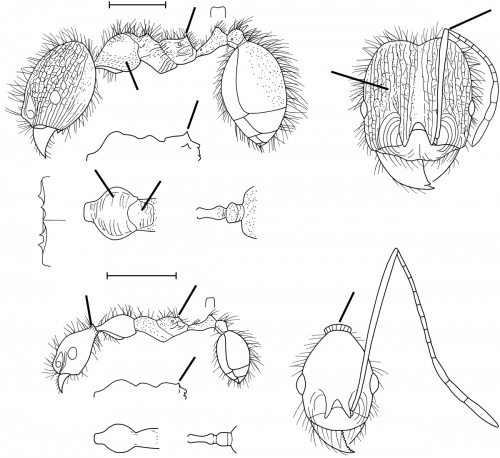Pheidole leonina
| Pheidole leonina | |
|---|---|
| Scientific classification | |
| Kingdom: | Animalia |
| Phylum: | Arthropoda |
| Class: | Insecta |
| Order: | Hymenoptera |
| Family: | Formicidae |
| Subfamily: | Myrmicinae |
| Tribe: | Attini |
| Genus: | Pheidole |
| Species: | P. leonina |
| Binomial name | |
| Pheidole leonina Wilson, 2003 | |
In terra firme forest, recruiting to dead cockroach. (Wilson 2003)
Identification
See the description in the nomenclature section.
Keys including this Species
Distribution
Only known from the type locality.
Latitudinal Distribution Pattern
Latitudinal Range: -9.466667° to -12.497473°.
| North Temperate |
North Subtropical |
Tropical | South Subtropical |
South Temperate |
- Source: AntMaps
Distribution based on Regional Taxon Lists
Neotropical Region: Brazil, Peru (type locality).
Distribution based on AntMaps
Distribution based on AntWeb specimens
Check data from AntWeb
Countries Occupied
| Number of countries occupied by this species based on AntWiki Regional Taxon Lists. In general, fewer countries occupied indicates a narrower range, while more countries indicates a more widespread species. |

|
Estimated Abundance
| Relative abundance based on number of AntMaps records per species (this species within the purple bar). Fewer records (to the left) indicates a less abundant/encountered species while more records (to the right) indicates more abundant/encountered species. |

|
Biology
Castes
Nomenclature
The following information is derived from Barry Bolton's Online Catalogue of the Ants of the World.
- leonina. Pheidole leonina Wilson, 2003: 315, figs. (s.w.) PERU.
Unless otherwise noted the text for the remainder of this section is reported from the publication that includes the original description.
Description
A member of the “jujuyensis complex” of the larger fallax group, comprising Pheidole araneoides, Pheidole cuevasi, Pheidole durionei, Pheidole jujuyensis, Pheidole kugleri, Pheidole leonina, Pheidole leptina, Pheidole lucretii, Pheidole lupus, Pheidole paraensis, Pheidole punctithorax, Pheidole tijucana, Pheidole wallacei and Pheidole wolfringi. P. leonina is distinguished as follows.
Major: occiput narrowed in full-face view; antennal scape exceeding occipital corner by more than its own maximum width; rugoreticulum on each side of dorsum of head in full-face view extends from anterior margin of head to edge of occiput, where it is replaced by rugulae; propodeal spines stout, short, equilaterally triangular; all of central strip of first gastral tergite shagreened.
Minor: propodeal spines reduced to denticles; occiput drawn into thin neck, with nuchal collar.
MEASUREMENTS (mm) Holotype major: HW 1.52, HL 1.60, SL 1.44, EL 0.30, PW 0.82. Paratype minor: HW 0.62, HL 0.92, SL 1.44, EL 0.22, PW 0.46.
COLOR Major: mandibles light reddish brown, body and antennae light reddish to yellowish brown, legs medium to dark yellow.
Minor: concolorous medium yellow.
Figure. Upper: holotype, major. Lower: paratype, minor. Scale bars = 1 mm.
Type Material
PERU: Cuzco Amazónico, 15 km northeast of Puerto Maldonado, Madre de Dios, col. Stefan Cover. Museum of Comparative Zoology
Etymology
L leonina, lion-like.
References
- Wilson, E. O. 2003. Pheidole in the New World: A dominant, hyperdiverse ant genus. Harvard University Press, Cambridge, MA. (page 315, fig. major, minor described)
- Albuquerque, E., Prado, L., Andrade-Silva, J., Siqueira, E., Sampaio, K., Alves, D., Brandão, C., Andrade, P., Feitosa, R., Koch, E., Delabie, J., Fernandes, I., Baccaro, F., Souza, J., Almeida, R., Silva, R. 2021. Ants of the State of Pará, Brazil: a historical and comprehensive dataset of a key biodiversity hotspot in the Amazon Basin. Zootaxa 5001, 1–83 (doi:10.11646/zootaxa.5001.1.1).
References based on Global Ant Biodiversity Informatics
- Bezdeckova K., P. Bedecka, and I. Machar. 2015. A checklist of the ants (Hymenoptera: Formicidae) of Peru. Zootaxa 4020 (1): 101–133.
